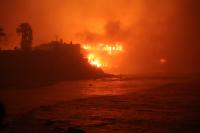World Expo Joint Pavilion No.3
Shanghai, China
Renovation Design on the top floor of previous World Expo Joint Pavilion No.3
Recently, DUTS Design completed a new working space design in Huangpu District. This project locates in the southern part of the Urban Best Practice Area, pervious Expo field of the Puxi, next to Huangpu River and Power Station of Art Museum. The landscape and cultural resources surrounding this area are abundant. This design redefines the interior functionality. It is a multiuse space that contains the capacity of conferences, exhibitions, shows, roadshows and parties. This space is also pointing to meet various requests from two companies that come from different fields of enterprises.
The building is formerly the World Expo Joint Pavilion No. 3 that retains the structure of the old factory. With an oversized terrace, the project is located on the top floor of this modern building. The interior depth is 32 meters, but the height is only 3.5 meter. It creates a test for the designer who wanted to break this boundary. To meet the functional needs of daily work between the two companies under relatively limited conditions was a challenge, too. In the end, the designers provide a space that has positive functions and additionally matches a “museum-level” multi-purpose exhibition hall.
The elevator on the west side and the escalator on the east side were still be retained after the area has been changed to office usage. After many deliberations, the designer finally figured the elevator is more accessible and closer to the intersection. It becomes the primary entry to the fourth floor. The design starts with the white elevator hall that increases the extension of horizontal façade. The "anti-gravity" conference room and tea room divided the area into two individual spaces. It also creates an encircling walkway that can be used as a multi-functional exhibition hall.
The longitudinal conditions limit the interior; therefore, emphasizes the extension of the lateral façade and expands the depth and breadth of the space became the principle of this design. Although the project is located on the south of Huangpu River, there are not many front-facing river views because the restricts by original escalators and facilities rooms. The conditions of longitudinal floorplan limit the interior design. The principle of this design became emphasizing the depth and breadth to extend the lateral façade. Because the restricts by original escalators and facilities rooms, there are not many front-facing river views even the project locates in the south of Huangpu River. We plan our front desk, reception area, and offices near the entry. The niche and door create a recessed space, and river view can be seen through this "box". The walls on the left and right sides of the front hall are covered with black steel plates. We use warm wooden plates to surround the inner face of this box. The balance between cold and warm represent the strong contrast with those white space around this area. The staggered wall niches break the monotonous environment. It riches the design of the façade.
After deducting the structure and the electromechanical air duct, the net height of the central area is only 3.5 meters. The designer places the largest conference room in this area. This room is separated from the ground with an elevated platform that extended 3.6 meters in three directions. The wedge façade creates an illusion to hide the steel structure inside of the construction. Although the conference room is gigantic, it generates a moderate and light appearance.Under the definition of the top surface and the ground, a dramatic "anti-gravity" effect is formed. At the same time, the extension space on the platform can be developed as a stage or showcase area. This walkway surrounding the conference room has unlimited scenarios that can be used as a multi-function scene.
The central conference room faces the north side of terrace. The ceiling extends from the top of the conference room to the outside awning. The same method that used on the façade makes the awning that is more than 11 meters looks as light as a paper. The tea room locates under this area. The designer wants to create an indirect connection between those two elements. In order to demonstrate this effect, the cantilevered awning is exaggerated and lightly shades the tea room.
"The sun never knew how great it was until it hit the side of a building." by Louis Kahn. The designer takes the advantages of the rooftop and places skylight windows to introduce natural lighting into the room. When sunlight penetrates through the skylight windows, the shadows reflect on the floor creates various patterns by different time of the day. In the original design, there was a staircase leading to the roof terrace under the skylight window,but the plan got canceled due to multiple reasons.
This design puts aside all the unnecessary decorations to represent the most authentic characteristics of this space. The whole area uses many basic materials such as cement brick, steel plate and wood. The color of black and white represent calm and rational. These are also the two primary colors in this space. At the same time, these colors can merge perfectly with other interior ingredients that have various chroma, brightness and saturation. The complete balance between beauty and simplicity is the ultimate goal, so people can feel pragmatic peace that created from the components in this space.
- Architekci Wnętrz
- DUTS Design Shanghai Office
- Location
- Shanghai, China
- Year
- 2019
- Lead Architect
- Ling Zhong
- Design Team
- Yingqi Hu, Wanggang Shi, Ke Xu
- Project Manager
- Wenjie Zhang
- Construction Team
- Xing Yuan























